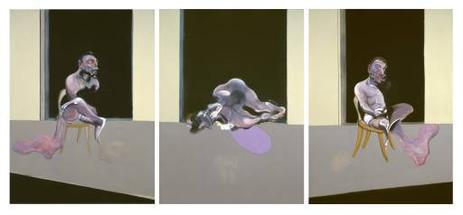In “Triptych May-June 1973,” each panel throbs with raw emotional intensity, reflecting Bacon’s attempt to process his grief and guilt. The triptych format, which Bacon favored for its narrative potential, here seems to dissect the moments of Dyer’s demise and its aftermath into a visceral visual meditation. The central panel is especially haunting, depicting a figure slumped over what appears to be a sink, an echo of Dyer’s tragic end. This image is flanked by scenes of contorted figures, their bodies twisted in pain or despair, set against dark, oppressive backgrounds.
Bacon’s use of color in this work is subdued, dominated by dark tones that underscore the somber theme, with bursts of white and red intensifying the emotional charge. His application of paint is characteristically aggressive and textured, enhancing the visual impact and the chaotic, almost brutal feeling of the scenes depicted. This textural depth contributes to the unsettling atmosphere, a hallmark of Bacon’s style, which often utilizes distorted forms and stark, geometric enclosures to convey isolation and turmoil.
Critically, the triptych is a poignant representation of Bacon’s themes of existential angst and vulnerability. It compels the viewer to confront the unsettling aspects of human existence, particularly the inevitability of death and the randomness of fate. Bacon’s portrayal of these themes does not aim for beauty in a traditional sense but seeks a deeper resonance through its stark and often disturbing imagery.
In the context of Bacon’s broader oeuvre, “Triptych May-June 1973” is a seminal work that exemplifies his ability to channel personal suffering into compelling art. It remains a powerful testament to his skill in portraying the complexities of human emotion, positioning him as a pivotal figure in 20th-century art. His works, particularly those that followed Dyer’s death, challenge viewers to reflect on their own experiences with grief and loss, solidifying Bacon’s reputation for confronting and depicting the rawest aspects of the human condition. This painting not only serves as a memorial to Dyer but also as an enduring exploration of the themes of loss, love, and the inexorable pull of mortality.







Commenti 0
Inserisci commento